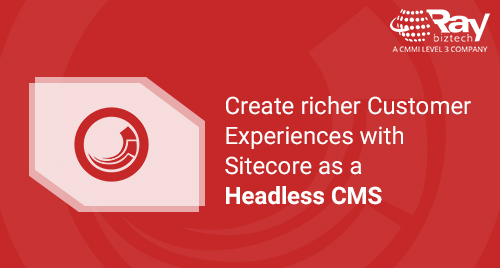Create richer Customer Experiences with Sitecore as a Headless CMS

Customers today, have ever-changing minds that move from one brand to another depending upon the experiences they receive. A good customer experience can be a key differentiator for a company. Content Management Systems (CMSs) would help companies to create best of customer experiences and retain customers. CMSs helps in collecting customer data, understanding customer needs, buying patterns, and designing offers that best suit the customers. Content overloading, inappropriate content can be a hindrance for a good Content Management System.
Choosing a CMS that best suits your organization needs, products and helps in defining your customer well is necessary. For a customer all e-commerce sites may look same, as their motive is mere online shopping, but for you it should be the best CMS.
Types of CMS
A coupled CMS focuses on content management and content delivery. It includes three sections: a database that stores the content, a web application/ content management that offers an interface to manage content and design, and content delivery that produces the HTML experienced by the visitor. Coupled or traditional CMS architectures closely link the backend to the frontend of a website.
A headless CMS is similar to decoupled CMS architecture, but does not have a distinct frontend system to which to publish. Whereas, a decoupled CMS includes additional templates, WYSIWYG editing, and other tools that are usually visible in traditional CMS systems.
Headless CMS - How it all started?
When the digital world was all about just the web, a CMS could easily handle authoring, storage, and presentation of designed websites. Content repositories that stored content and dynamically delivered it to a page were further optimized for HTML templates. Everything was coupled properly and there were huge performance benefits to this all-round closeness. Later, with the introduction of mobile revolution and the internet of things (IoT) as well as an increase in number of devices in the market that did not use HTML, cracks started to began in coupled CMS. The content repositories, which were web-page-centric, did not work well with non-HTML formats. They were not designed to use the latest front-end technologies without hacks or considerable development work. They were not ready for a fluid and responsive web apps in which pages dynamically update as users interact with them. They could not adjust to a new era of content in which content objects were delivered via an API.
The content (that was no longer optimized for HTML or any other format) was accumulated and easily retrieved from the headless CMS. Front-end developers started using tools they liked, could easily take care of the look, feel, and functionality of the user’s experience on web, mobile, or other channels.
Headless CMS and its decoupled representation have untied developers from the convention and structures of the back end. Now they no longer have to deal with the peculiarities of a CMS rendering system and technology be it .NET, JAVA, PHP, or Ruby. As an alternative, they can access pure-code fragments of content that are not already in the final representation of the page. Using the latest open-source JavaScript libraries and frameworks, developers can quickly build rich applications and get full control over the user experience.
Necessity for a Headless CMS
Headless CMS helps in collecting different parts of content from a single content repository and later displays it on various channels using different components. Headless CMS also promotes multi-channel and multi-device content circulation. Your audience is everywhere, and headless CMS architectures ensure your developers can quickly reach them with rich experiences on mobile apps and IoT-connected devices.
Headless CMS delivers content through an API to any type of application that can consume an API, offering limitless options for implementing new applications. It can be a great fit in environment where you publish content once and it is consumed by several parties, on websites and web apps that use JavaScript frameworks (i.e. React, Angular), and in native mobile apps (iOS, Android). It can also actually enrich product information on e-commerce sites.
Role of Sitecore as Headless
Sitecore CMS is exclusively designed and best suits the modern, multi-channel world. Sitecore has an architecture that allows marketers to deliver personalized content and developers to work with familiar tools to seamlessly deliver it on any device. Recently, Sitecore introduced its latest version, Sitecore Experience Platform (XP), Version 9, that promises to combine the entire customer data and interactions from various campaigns and other data sources into a single secured platform. The objective is to offer marketers with a constant, holistic, synchronized view of the customer.
Sitecore is originally designed as a headless CMS. It stores content as items, and Sitecore’s layout engine places those objects, or modules, in a web presentation format. Likewise, a mobile app developer can use Sitecore API to call those content objects and reuse them in a mobile app. When a marketer makes any changes in your brand’s web content in Sitecore, those changes are automatically reflected across various channels on which you have called or reused those content objects. With Sitecore Experience Editor, you can edit and preview content components (or modules) on a page.
With its new version, Sitecore 9, Sitecore has introduced JavaScript Sitecore Services (JSS), which is a complete SDK for JavaScript developer. By allowing developers to build full-fledged solutions using Sitecore and modern JavaScript UI libraries and frameworks, it will close the space between back-end and front-end developers. All relevant Experience Platform capabilities are conserved, including Experience Editor, Personalization, MV testing and Tracking/Analytics. JSS will offer front-end developers flexibility to build sites using any tools without the limitations of back-end structures and conventions. It will also allow marketers to get insights context, leverage personalization, and optimize user experiences.
Powered by Sitecore 9, headless CMS will change the entire digital marketing landscape. Now companies can create web apps, mobile apps, and single page apps using Sitecore JSS to increase their market and can reach diverse user segments.
About Raybiztech
Raybiztech is a leading Global Information Technology (IT) Services and Solutions, a CMMI Level 3, ISO 27001:2022 Certified Company. We are a Member of NASSCOM, HYSEA, NJTC, and AIIA. Raybiztech offers comprehensive end-to-end IT Services for Business Application Development, Enterprise Solutions, Enterprise Collaboration Services, Testing and Quality Assurance Services, Cloud Computing and IT Infrastructure Management to organizations in the Banking & Finance, Insurance, Healthcare, Manufacturing, Retail, Media & Entertainment, Leisure & Travel, Telecom and Energy & Utilities verticals as well as Independent Software Vendors.

